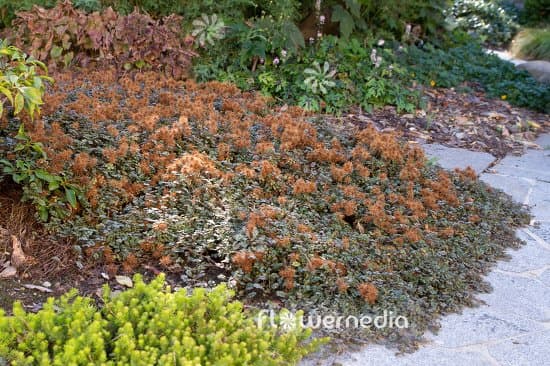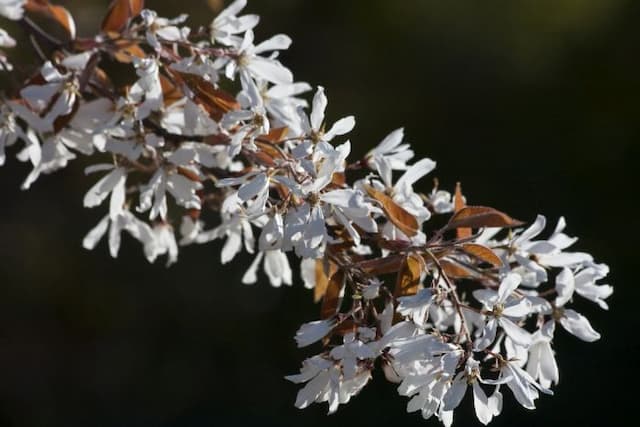Serviceberry Amelanchier arborea Tradition = 'Trazam'
![tree amelanchier [Tradition]](/_next/image?url=https%3A%2F%2Fplants-admin.emdemapps.com%2Fimages%2Fplants%2F%2Fimages%2F604b56afa99a2.png&w=3840&q=75)
ABOUT
The Amelanchier arborea Tradition, commonly known as the Serviceberry, is a deciduous plant well-admired for its seasonal beauty and ornamental features. In the early spring, the Serviceberry is a breathtaking sight as it becomes covered with a profusion of white, star-shaped flowers borne in drooping clusters, which add a delicate and slightly fragrant display to the landscape. Following the floral show, the foliage emerges, adding further interest; the leaves are oval to rounded in shape, with fine serrations along the edges, and start as a bright, fresh green color. Come fall, the foliage transforms into a stunning array of oranges, reds, and yellows, creating a warm and vibrant autumnal palette. In addition to its attractive leaves and blossoms, the Serviceberry develops small, round pome fruits in the summer, which shift from a green to a deep, dark purple or almost black color when ripe. These berries are not only visually appealing against the backdrop of the green leaves but are also a favorite amongst birds and wildlife, as well as being edible for humans with a sweet, slightly almond flavor. The Serviceberry features a smooth, gray bark that provides winter interest, along with its pleasing branch structure that can be appreciated after the leaves have fallen. This combination of ornamental features—the spring flowers, the summer fruit, the fall foliage, and the winter bark—makes the Serviceberry Tradition a full package of visual delights throughout the seasons, regardless of specific measurements.
About this plant
 Names
NamesFamily
Rosaceae.
Synonyms
Downy Serviceberry, Shadbush, Shadwood, Shadblow, Juneberry, Sarvisberry, Serviceberry, Wild Pear, Juneberry.
Common names
Amelanchier arborea.
 Toxicity
ToxicityTo humans
Amelanchier arborea, commonly known as serviceberry, is not considered toxic to humans. In fact, its berries are edible and often eaten fresh or used in jams, jellies, and pies. No significant toxicity or symptoms of poisoning are expected from ingesting any part of this plant for most individuals. However, it is always possible for someone to have an individual allergy or sensitivity to any plant.
To pets
The serviceberry is not known to be toxic to pets such as dogs and cats. The fruits of Amelanchier arborea are generally regarded as safe for pet consumption in moderation. No specific symptoms of toxicity or adverse consequences are typically associated with pets ingesting parts of this plant. However, ingestion of large quantities of any non-typical food can cause gastrointestinal upset in some pets.
 Characteristics
CharacteristicsLife cycle
Perennials
Foliage type
Deciduous
Color of leaves
Green
Flower color
White
Height
15-25 feet (4.57-7.62 meters)
Spread
15-25 feet (4.57-7.62 meters)
Plant type
Tree
Hardiness zones
4-9
Native area
North America
Benefits
 General Benefits
General Benefits- Attractive Spring Flowers: The Amelanchier arborea Tradition, commonly known as the Downy Serviceberry, boasts stunning white flowers in early spring, adding aesthetic value to landscapes.
- Edible Fruit: It produces small, sweet berries in summer that are edible and can be used in jams, jellies, and pies.
- Autumn Foliage: Downy Serviceberry features striking fall foliage with colors ranging from yellow to red, enhancing the visual interest of gardens in the autumn season.
- Wildlife Habitat: The tree provides a habitat and food source for birds and pollinators, supporting local ecosystems.
- Small Stature: Its relatively compact size makes it suitable for urban and suburban landscapes, including small yards and gardens.
- Drought Tolerance: Once established, Downy Serviceberry has good drought tolerance, making it a low maintenance choice for a variety of settings.
- Four-Season Interest: With flowers in spring, fruit in summer, colorful leaves in fall, and an interesting branching structure in winter, the Downy Serviceberry offers year-round interest.
 Medical Properties
Medical Properties- This plant is not used for medical purposes.
 Air-purifying Qualities
Air-purifying QualitiesThis plant is not specifically known for air purifying qualities.
 Other Uses
Other Uses- Wildlife Habitat: Serviceberry provides shelter and nesting sites for a variety of birds and small mammals.
- Photography: Its ornamental features, especially during spring bloom and autumn color, make serviceberry a favored subject for nature photographers.
- Winter Interest: Serviceberry's structure, including its silver-gray bark and graceful form, adds visual interest to barren winter landscapes.
- Dye Production: The bark and leaves can be used to create natural dyes for fabrics or crafts.
- Woodworking: Serviceberry wood is hard and dense, suitable for making small wooden items such as tool handles or walking sticks.
- Educational Tool: Serviceberry's various stages of growth can be used to teach botany and natural science in educational settings.
- Erosion Control: Serviceberry, with its extensive root system, is planted on slopes and banks to help stabilize soil and prevent erosion.
- Bonsai Cultivation: Its attractive form and adaptability make serviceberry a candidate for bonsai creation and display.
- Cultural Symbolism: Serviceberry can serve as a symbol in cultural ceremonies and is sometimes planted in memory of a loved one.
- Litter Reduction: The dense foliage of serviceberry can reduce the amount of litter blowing into an area by acting as a windbreak.
Interesting Facts
 Feng Shui
Feng ShuiThe Serviceberry is not used in Feng Shui practice.
 Zodiac Sign Compitability
Zodiac Sign CompitabilityThe Serviceberry is not used in astrology practice.
 Plant Symbolism
Plant Symbolism- Renewal and Hope: Amelanchier arborea, commonly known as the Serviceberry, is known for its early spring blooms, which signify the end of winter and the promise of renewal and new beginnings.
- Native American Heritage: Serviceberry has strong ties with Native American culture, where it has been used in traditional medicine and as a food source, symbolizing the plant's importance in indigenous heritage and knowledge.
- Passage of Life: The Serviceberry's cycle of flowering, fruiting, and dormancy mirrors the human life cycle, symbolizing birth, life, and death, and the idea that each phase has its own beauty and significance.
- Provision and Nourishment: With its edible berries that attract birds and wildlife, the Serviceberry represents the provision of sustenance and the interconnectedness of ecosystems.
- Beauty and Grace: The delicate white flowers and graceful form of the Serviceberry tree are often associated with purity, beauty, and elegance, making it a symbol of aesthetic and inner beauty.
 Water
WaterThe Downy Serviceberry, also known as the Amelanchier arborea 'Trazam', should be watered deeply to encourage root growth, generally providing about 1 to 1.5 gallons per week for an established tree during the growing season. Newly planted Serviceberry trees require more frequent watering, about twice per week, ensuring the root ball remains moist. During periods of drought or extreme heat, increase watering frequency to maintain soil moisture but avoid water logging. Reduce watering in the fall before the tree goes dormant and during winter months when the tree requires less water. Always check the soil moisture to a depth of 2 to 3 inches before watering to prevent overwatering.
 Light
LightThe Downy Serviceberry thrives in full sun to part shade conditions. It is best situated in a location where it can receive at least six hours of direct sunlight per day. However, it can tolerate some shade, especially in the hotter part of the day, making it adaptable to light conditions in urban landscapes.
 Temperature
TemperatureThe ideal temperature range for the Downy Serviceberry is between 60°F to 85°F during the active growth season. This plant is cold hardy and can withstand temperatures down to at least -20°F, but not under prolonged extreme cold without some form of protection. Serviceberry trees are also heat tolerant and can survive heat up to 90°F, although extended periods of high heat may stress the plant.
 Pruning
PruningPruning the Downy Serviceberry should be done primarily to remove any dead or damaged branches, to shape the tree, and to encourage healthy growth. The best time to prune is late winter or early spring before new growth starts, but after the coldest weather is over. However, since Serviceberry trees flower on old wood, be cautious not to over-prune as this can reduce the flowering and subsequent fruit production.
 Cleaning
CleaningAs needed
 Soil
SoilThe best soil mix for the Downy Serviceberry 'Trazam' is well-draining, fertile, loamy soil with a pH of 6.0-7.5. It benefits from added organic matter.
 Repotting
RepottingDowny Serviceberry 'Trazam' is typically planted outdoors and does not require repotting. Adjust soil and root space as it matures if planted in a large container.
 Humidity & Misting
Humidity & MistingDowny Serviceberry ‘Trazam’ is adaptable but prefers moderate humidity levels similar to its natural wooded habitat.
 Suitable locations
Suitable locationsIndoor
Not ideal indoors; needs full sun, ample space.
Outdoor
Plant in full sun to part shade, well-drained soil.
Hardiness zone
4-9 USDA
 Life cycle
Life cycleAmelanchier arborea 'Trazam', commonly known as the Serviceberry or Downy Serviceberry, begins its life as a seed, which, after a period of dormancy and under the right conditions of moisture and temperature, germinates. The seedling emerges with a set of embryonic leaves and continues growth into a young sapling, establishing a root system and beginning to produce true leaves. As the plant matures, it develops a woody stem and branches, entering a vegetative stage where it grows leaves for photosynthesis. After a few years, it reaches sexual maturity and produces flowers each spring; these are typically white and five-petaled, which then lead to the production of small, apple-like fruits by summer. These fruits attract birds and other wildlife that aid in seed dispersal. The Serviceberry completes its life cycle when it either dies naturally after a lifespan that can reach over 50 years or is cut down, with seeds having spread to create new plants.
 Propogation
PropogationPropogation time
Spring
Amelanchier arborea, commonly known as downy serviceberry or shadbush, is often propagated by seed, but the cultivar 'Trazam', also known as the TRADE® Amelanchier, is commonly propagated through softwood cuttings. This method is usually carried out in late spring or early summer when the new growth is still flexible but mature enough to sustain itself independently. To propagate 'Trazam' by cuttings, select healthy, non-flowering shoots and cut sections that are 4 to 6 inches long, making sure each cutting has several leaf nodes. Remove the leaves from the lower half of the cuttings to prevent moisture loss, and dip the base of the cuttings in rooting hormone to enhance root development. The cuttings can then be planted in a well-draining soil mix, ensuring the remaining leaves are above the surface. The soil should be kept consistently moist, but not waterlogged, and the cuttings should be placed in a well-lit area but out of direct sunlight to avoid drying out. Rooting typically occurs within a few weeks, after which the new plants can be gradually acclimated to outdoor conditions before transplanting.





![Strawberry [Just Add Cream]](/_next/image?url=https%3A%2F%2Fplants-admin.emdemapps.com%2Fimages%2Fplants%2F%2Fimages%2F604b5f8e7d168.png&w=640&q=75)



